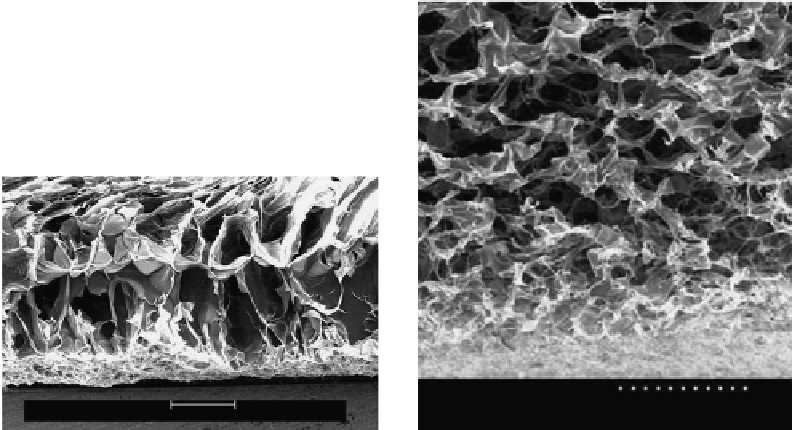Biomedical Engineering Reference
In-Depth Information
(b)
(a)
A
060911
20KV
X300
100μm
Acc.V
20.0 kV
Spot
3.0
Magn
40x
Det
SE
WD
8.8
500 μm
Figure 9.3
Scanning electron microscopy (SEM) section morphology of chitosan-gelatin (a) and chitosan-gelatin-HA
scaffold (b) directed contact prefreezing methods. (From Liu, H. F. et al. 2004.
J Biomater Sci Polymer Edn
15:
25-40; Mao, J. S. et al. 2003.
Biomaterials
24: 1067-1074. With permission.)
technology is not easily controlled. RP makes it possible to produce tissue engineering
scaffolds with predefined and reproducible internal microstructures. Moreover, the scaf-
fold was designed to mimic the architecture of natural tissue. Li and coworkers [9] pre-
pared chitosan-gelatin porous scaffolds with a well-defined internal morphology by RP,
microreplication, and freeze-drying techniques.
9.2.2 Chitosan-based Fiber Scaffolds
The natural ECMs in the body are mainly composed of two classes of extracellular macro-
molecules: proteoglycans and fibrous proteins with fiber diameters ranging from 50 to
150 nm, depending on tissue type. Nanofibrous composite scaffolds are an ideal choice for
tissue engineering because of their heterogeneous nature, matching that of the ECM, large
surface area-to-volume ratio, ability to facilitate diffusion (as a result of high porosity), and
tunability of physical properties [10]. For chitosan, in the solid state, relatively rigid crystal-
lites form due to the regularly arranged hydroxyl and amino groups at equatorial posi-
tions in the β(1,4)-linked d-glucosamine repeating units, while in solution, hydrogen
bonding drives the formation of microfibrils, depending on chitosan concentration. Such
characteristics of chitosan guide the methodology for successful electrospinning of this
material [11]. Technologies for chitosan fiber production have been established during the
last two decades. The electrospinning process can be used for the production of thin
chitosan fibers down to the nanometer scale. In many studies, chitosan fibers are made by
the wet-spinning process, which produces fibers by first dissolving the polymer in a sol-
vent and then extruding the polymer solution via dies into a nonsolvent. Scaffolds pre-
pared from chitosan fibers could combine adequate porous structure with sufficient
degradability and mechanical properties [12].

Search WWH ::

Custom Search